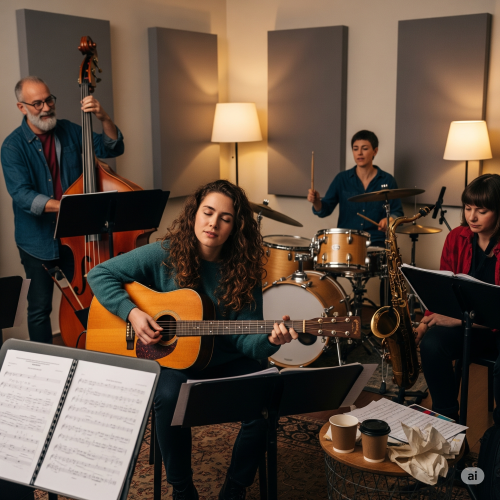Musical practice is important for improving musical skills, understanding different sounds and rhythms, and building confidence in performing music.
- Music Listening
Music listening means paying close attention to the sound, rhythm, melody, and message of music. It helps us understand and enjoy music better.
Types of Listening:
- Casual listening – Hearing music without focus (e.g., background music).
- Focused listening – Paying full attention to details in music.
- Analytical listening – Studying music deeply to understand its structure.
Benefits of Music Listening:
- Trains the ear to recognize sounds.
- Improves memory and focus.
- Builds love for traditional and modern music.
- Popular Music Genres
Popular music genres are different types or categories of music that people enjoy. Each genre has its own unique style, rhythm, and cultural background.
Types of Popular Music Genres
- Afrobeat: A music style that mixes traditional African rhythms with jazz and funk. It is known for strong drum patterns and social messages.
- Highlife: A genre that combines African rhythms with Western instruments like guitars and horns. It is often lively and used for celebrations.
- Juju: A Nigerian music style that features talking drums and guitars, blending traditional Yoruba sounds with modern music.
- Gospel: Religious music that praises God, usually sung in churches with powerful vocals.
- Hip-hop: A modern music genre that includes rap and rhythmic beats, often telling stories about life and society.
- Musical Styles
Musical styles refer to the different ways music is performed, arranged, or expressed. Each style has its own unique sound, instruments, rhythm, and purpose. These styles often reflect the culture, beliefs, or time period of the people who create them.
- Traditional Music: This music is passed down from one generation to another. It is based on the customs and culture of a community. Traditional music is often performed during festivals, ceremonies, and local events, using instruments like drums, flutes, and talking drums.
- Classical Music: This style follows strict rules of composition and is usually performed by orchestras or choirs. It is often calm and serious, used in formal settings like concerts or religious services. Famous composers include Beethoven and Mozart.
- Modern Music: Modern music is created in recent times and includes popular genres like hip-hop, gospel, Afrobeat, and reggae. It is influenced by technology and is mostly heard on radio, television, and social media.
- Musical Instruments
Musical instruments are tools or devices used to produce musical sounds. Different instruments create different sounds, and they are grouped based on how they produce these sounds.
groups of musical instruments:
- Percussion Instruments: These produce sound when struck, shaken, or scraped. They keep the rhythm and add beats to music.Examples: Drums, tambourines, maracas, xylophones.
- Wind Instruments: These produce sound when air is blown through them. They can be made of wood or metal.Examples: Flutes, trumpets, saxophones, clarinets.
- String Instruments: These produce sound when their strings are plucked, struck, or bowed.Examples: Guitars, violins, harps, pianos (strings inside).
- Keyboard Instruments: These produce sound when keys are pressed, which activate strings, pipes, or electronic sounds.Examples: Piano, organ, synthesizer.
- Singing and Vocal Practice
Singing and vocal practice involve using the voice to produce musical sounds. It is an important part of music that helps people express emotions and tell stories.
Key aspects of singing include:
- Breathing: Learning how to control breathing helps singers hold notes and sing smoothly.
- Pitch: Singing the correct notes in tune is important to sound good.
- Voice control: This includes managing volume, tone, and expression to make singing interesting.
- Pronunciation: Clear words help the audience understand the song.
- Practice: Regular singing practice helps improve strength, range, and confidence.
- Rehearsal and Performance
Rehearsal means practicing music before a public performance. It helps musicians prepare, correct mistakes, and improve their skills.
- During rehearsal, musicians learn their parts and work together to make the music sound good.
- It allows performers to build confidence and fix any problems.
- Rehearsals may happen many times before the actual performance.
Performance is when musicians play or sing music in front of an audience. It can be at concerts, festivals, school events, or ceremonies.
- A good performance shows skill, confidence, and expression.
- Musicians use what they learned in rehearsals to entertain and connect with the audience.
- Performing helps musicians gain experience and improve for future shows.

